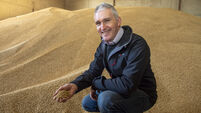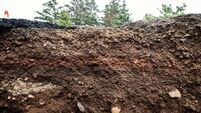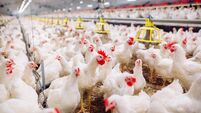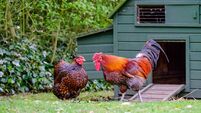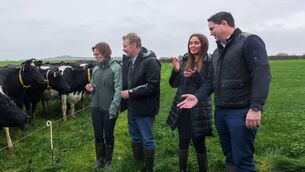Signpost: Following the research on meal feeding at grass

Richard Long on his farm at Knockaunbrandaun, County Waterford. Picture: Dan Linehan
The year seems to be moving at a rather rapid pace and who would have thought that changeable weather in late June would have us reaching for a coat and hat?
As we enter July, the focus begins to switch to readying animals for slaughter and the first step in this involves carrying out a mid-season weighing.
The crop of 2021-born animals contain a mixture of continental and early-maturing steers and heifers and differing finishing strategies will be required to finish these animals.
Since turnout back in March, the daily weight gain target was set at 0.9kg/head/day for early-maturing heifers and at least 1kg/head/day for all other animals. And, as the scales never lie, the only true way to see how these animals perform will involve an on-farm weighing.
Ideally, I’m aiming to have the early-maturing heifers within 60 days of finish on August 1, with the aim to have these animals weighing 510-520kg at slaughter, producing a 240-250kg carcass.
For this to be achieved, I’m targeting an average weight of approximately 450kg in mid-July. I’ll also target a small number of steers for finishing prior to housing; the selection criteria for these largely centre on their level of forwardness or fatness when meal is being introduced to the heifers.
Some of the steers – especially the Angus and Hereford types – tend to be stocky in build – and if they are sufficiently heavy, they will join the heifer group, which will be supplemented with 3-4kg/head of meal per day for approximately 60 days.
Moving the age of slaughter of the early-maturing heifers back from a shed finish to killing prior to going into the shed is something which has worked here over recent years.
Previously they were moved at approximately 24 months, but now – through improved lifetime performance – they’re being sold approximately three months earlier at similar carcass weights while consuming substantially lower volumes of concentrates and silage.
Away from the older stock, meal feeding has been ceased for approximately three weeks at this point for the older and stronger group of calves. I’m taking a leaf out of the book of research in Teagasc Grange on this regard, as it shows that there was no advantage to providing early-born calves with meal over the summer months on their overall lifetime performance. These animals will also be weighed in the middle of July and hopefully they’ve achieved their targeted daily gain of 0.7kg/head/day.
However, I will continue to offer some of the younger calves – especially those born in March – concentrates throughout the summer. I’ve found over the years that these later-born animals really benefit from this about 1kg/head/day over the summer months. And, on the farm here, if they don’t receive it, I’ll have a light weanling coming into the shed, leading to a light animal going out and ultimately a delay in slaughter in the backend of 2023.
Come September, meal feeding will recommence to all 2022-born calves up until housing. Grass quality at this time of the year tends to be similar in nutritive content to grass silage and to ensure that they continue to perform, they’ll need supplementation.


